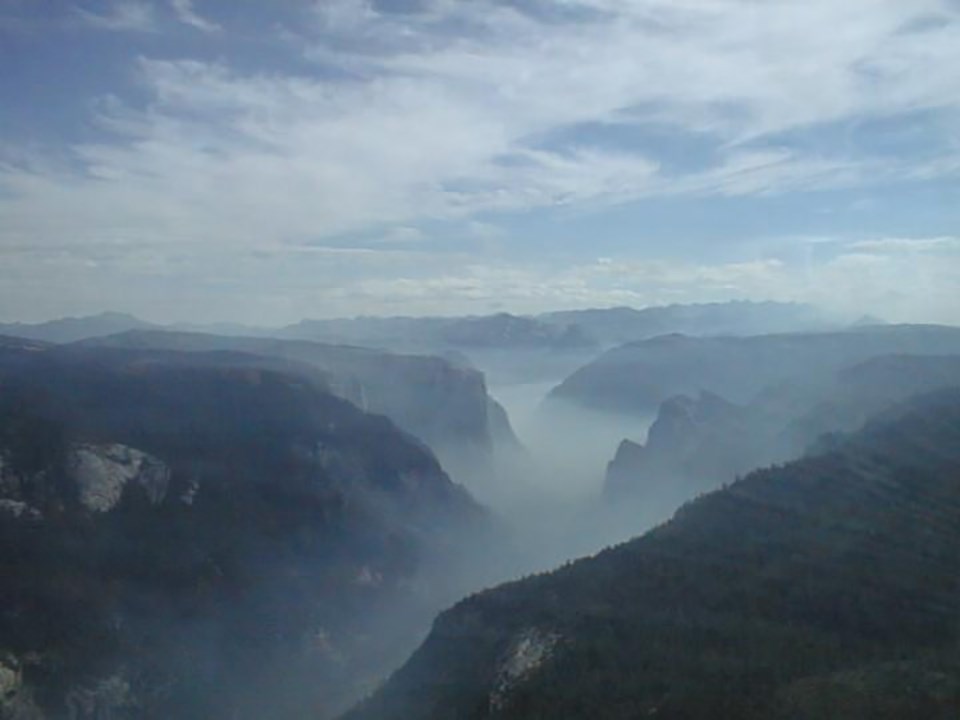|
When visiting Yosemite, it is possible to see fire and smoke at any time of the year. Beginning in fall through early spring, piles from mechanical thinning projects are often being burned in various areas throughout the park and along roadways. Spring, summer, and fall are all busy seasons for fire whether from prescribed fires, or managed wildfires. Where there is fire, there is smoke. During both prescribed fires and managed wildfires smoke and air quality conditions are consistently being monitored to help minimize smoke impacts. However, it is inevitable that some smoke will be present—whether on roadways, in campgrounds, or in areas that obscure vistas. If you are sensitive to smoke, you may consider visiting an area of Yosemite where fire or smoke is not present, and taking any other precautions that will help lessen smoke-related health problems. It is a unique and exciting opportunity to observe fire in the wilderness. If possible, Yosemite attempts to leave nearby roads and trails accessible during fire projects so that visitor services are not compromised. When conditions allow, this can be a great chance for people to learn more about natural fire firsthand. 
Smoke ManagementFire managers are aware of the need for smoke management in order to reduce impacts to park visitors and neighboring communities. Yosemite Fire and Aviation works closely with park air quality managers to calculate how much smoke may be produced based on the vegetation (fuel) type, number of acres, and meteorlogical conditions. Portable and stationary particulate monitors are placed in areas that are most likely to see impacts of smoke during certain hours of the day. The local Air Quality Districts use the data from these monitors to issue air quality alerts and notices. During times where smoke from a wildland fire is affecting the park, the local Air Quality District will send out alerts and notices. We work closely with local districts to maintain that conditions are within legal limits and not posing threats to people in nearby communities. Overall, we want you to have a positive experience visiting or living near Yosemite, while also learning about fire's important role in the ecosystem. Allowing fires to burn naturally can result in a healthier, more diverse ecosystem. Reducing fuel buildup minimizes the potential for future catastrophic fires. Although the current fire may have transient, moderate smoke impacts, more severe fires can cause unhealthy levels of smoke for extended periods, over a much wider area. If you have low tolerance for smoke, take these measures to reduce your exposure in places where smoke from wildland fire is occurring:
Learn more about air quality monitoring in Yosemite. 
Yosemite Air Quality MonitoringFine particles/smoke at the Yosemite Valley Visitor's Center The chart below plots both the 1-hour and running 24-hour average PM2.5 concentration, but only the 24-hour average should be used to compare with the standard. The standard is exceeded when the 24-hour concentrations go above 35 micrograms per cubic meter, as denoted by the line with the label NAT'L AMBIENT AIR QUALITY STANDARD. The background of the chart is color coded and relates to the EPA National Ambient Air Quality Standard for particulate matter, which is designed to protect human health.
Yosemite WebcamsYosemite is always accessible to you! View current conditions from any of our five webcams.
Yosemite Observer Dashboard: Air QualityVisual, interactive information about current weather, stream flow, fires, and air quality conditions; all on one site! Campgrounds and CampfiresYosemite has 13 campgrounds, each with many campsites, and therefore, many campfires. Emissions from many simultaneous campfires can degrade air quality on a local scale. This is especially true in the nighttime and early morning hours, when inversions trap and concentrate fine particles from those campfires near the ground, creating local conditions that are potentially unhealthy for sensitive individuals. Campground Fire PreventionEach year campfires, smoking, and human carelessness cause unwanted fires in Yosemite. You can help prevent these fires by following a few fire safety tips. Make sure to check with a Ranger if you are unsure. Charcoal Briquettes
Camping Stoves and Lanterns
Smoking
Campfires
Fireworks Are Illegal in Yosemite National Park |
Last updated: August 21, 2023


